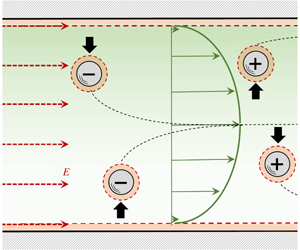Article contents
Electrokinetically enhanced cross-stream particle migration in viscoelastic flows
Published online by Cambridge University Press: 08 July 2020
Abstract

Advancements in understanding the lateral migration of particles have helped in enhanced focusing in microfluidic devices. In this work, we investigate the effects of electrokinetics on particle migration in a viscoelastic flow, where the electric field is applied parallel to the flow. Through experiments and use of perturbation theory in conjunction with the reciprocal theorem, we show that the interaction of electrokinetic and rheological effects can result in an enhancement in migration by an order of magnitude. The theoretical analysis, in agreement with the experiments, demonstrates that the particles can be focused at different equilibrium positions based on their intrinsic electrical properties.
JFM classification
Information
- Type
- JFM Papers
- Information
- Copyright
- © The Author(s), 2020. Published by Cambridge University Press
References
Choudhary et al. supplementary movie 1
The movie shows the particles entering the channel, with no potential difference applied at the channel ends. The figure corresponds to fig.1 (a). Other parameters are described in the caption of Fig.1 of the main text.
Choudhary et al. supplementary movie 2
The movie shows the particles exiting the channel, with no potential difference applied at the channel ends. The figure corresponds to fig.1 (a). Other parameters are described in the caption of Fig.1 of the main text.
Choudhary et al. supplementary movie 3
The movie shows the particles entering the channel, with +600V potential difference applied at the channel ends. The figure corresponds to fig.1 (c). Other parameters are described in the caption of Fig.1 of the main text.
Choudhary et al. supplementary movie 4
The movie shows the particles exiting the channel, with +600V potential difference applied at the channel ends. The figure corresponds to fig.1 (c). Other parameters are described in the caption of Fig.1 of the main text.
Choudhary et al. supplementary movie 5
The movie shows the particles entering the channel, with -600V potential difference applied at the channel ends. The figure corresponds to fig.1 (b). Other parameters are described in the caption of Fig.1 of the main text.
- 15
- Cited by

